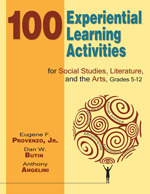100 Experiential Learning Activities for Social Studies, Literature, and the Arts, Grades 5-12
- Eugene F. Provenzo, Jr. - University of Miami, USA
- Dan W. Butin - Merrimack College, USA, Cambridge College
- Anthony Angelini - Gettysburg Area School District
"This unique contribution is both a wonderful source of teaching ideas and a reminder that authentic learning involves engaging experiences that encourage inquiry."
—Dan Thompson, Assistant Professor of Education
Penn State University
"Educators are always looking for interesting activities that challenge students to think beyond the ordinary. The authors have done a great job of compiling a variety of activities for different subject areas."
—India Meissel, Social Studies and English Teacher
Lakeland High School, Suffolk, VA
Encourage critical thinking while teaching meaning through learning experiences!
Learning in secondary school classrooms involves much more than students reciting the "right" answers on high-stakes tests. This activity-packed book encourages educators to move beyond traditional models of teaching and learning and provides them with the tools for getting started.
100 Experiential Learning Activities for Social Studies, Literature, and the Arts, Grades 5–12 focuses on using active learning to engage students in critical thinking and reflection about complex content knowledge in the humanities and the arts. Through easy-to-use matrices, the authors link lessons investigating history, economics, literature, music, and visual arts to McREL, NCTE, and NCSS standards. The 100 activities address significant social issues, including social justice, culture, language, and diversity. Teachers can emphasize comprehension, encourage creative thinking, and promote transfer across disciplines to help students:
- Explore primary sources to uncover practical and relevant information
- Construct careful arguments to integrate new learning with prior knowledge
- Question deeply held assumptions to arrive at authentic understandings
- Approach new ideas with confidence
Take your students through meaningful learning experiences and make knowledge come alive!
"Educators are always looking for interesting activities that challenge students to think beyond the ordinary. The authors have done a great job of compiling a variety of activities for different subject areas."
"The attention to critical thinking and problem solving sets this collection of activities apart from others."
"This unique contribution is both a wonderful source of teaching ideas and a reminder that authentic learning involves engaging experiences that encourage inquiry."
